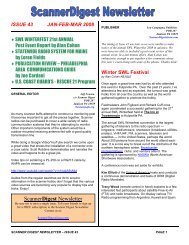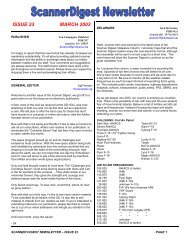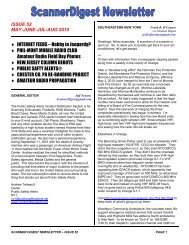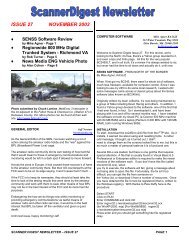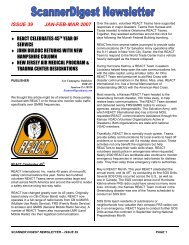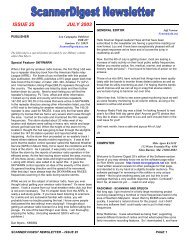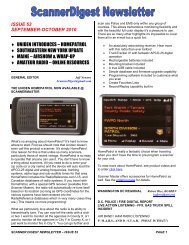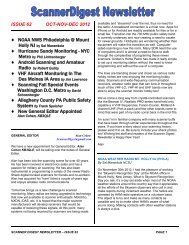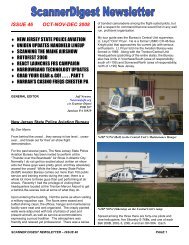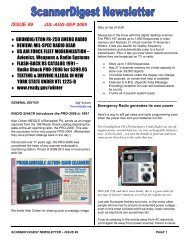Issue 58 - Scanner Digest Newsletter
Issue 58 - Scanner Digest Newsletter
Issue 58 - Scanner Digest Newsletter
Create successful ePaper yourself
Turn your PDF publications into a flip-book with our unique Google optimized e-Paper software.
The change will address “one of the biggest issues facedevery day by firefighters, fire police, EMS and firstresponders,” said Winslow Fire Chief Terrence Osborne.“It is a major concern when the ability to talk to each otherdoesn’t exist or is limited.”The new system also is expected to end a problem withinterference on police radios due to digital TVtransmissions.The expansion would include the ability to integrate allcounty police dispatch services, officials said. Countywideservice already exists for fire and EMS dispatch, they said.Freeholders approved the purchase of the radioequipment from Motorola Solutions Inc. at their meeting inCamden on Thursday. They also approved the separatepurchase of backup radios and other equipment from thesame firm for about $285,000.Reach Jim Walsh at (856) 486-2646 or jwalsh@gannett.comAMATEUR RADIORobert Gulley AK3Qak3q@ak3q.comAmateur Radio: Satellites and Scanning Part 1By Robert Gulley AK3QEmail: ak3q@ak3q.comI have enjoyed a number of hobbies over the years, but Ibelieve the radio hobby has been the most rewardingoverall because it continues to stimulate my curiosity.There are endless opportunities for trying new things, andI am amazed at what has been accomplished in this field.For example, did you know folks regularly bounce signalsoff the moon to talk with other hams around the world?(Yes, I said THE MOON!) Think about this for a moment: asignal originating here on earth travels almost half amillion miles round-trip and is received a few seconds latersomewhere else around the world. I doubt even Marconicould have imagined such a feat!Working Amateur SatellitesIf you are an Amateur Radio operator chances are youhave heard about working satellites or the InternationalSpace Station (ISS), if only as you studied for your radiolicense. You may also have heard about Amateur Radiosatellites built for and by Amateur Radio operatorslaunched into space specifically for use by hams aroundthe world. If you are a scanning enthusiast, you may havenever thought about using your scanner to receive satellitetransmissions, but you can. Most signals are onfrequencies regularly available to most scanners.Even if you know about all the satellites up in the sky,what you may not have realized is just how easy it is tolisten to or even make contact with (if you are a ham)these “birds” as they are affectionately known. You do notneed expensive equipment to listen to or contact some ofthese satellites, and even contacts with the space stationare possible using rather meager equipment.The main difficulty with contactingthe ISS is not the complexity ofthe process involved in makingthe contact, but rather the limitedamount of time astronauts canspend on the air. Hearing the ISSor one of the many satellites asthey fly overhead is fairly easy—itjust requires some patience,technique, and an ever-presentspirit of adventure!One of the more exciting aspects of Amateur Satellitework is the role Hams have played in their development aswell as the truly international cooperation of the AMSATcommunity. Many nations have built and launchedsatellites, and this spirit of cooperation represents the bestof the Amateur community. And even if you are not anamateur radio operator, there is a lot of enjoyment to behad listening in on the multitude of satellite transmissionsthat take place every day, including data, telemetry, andvoice operations.Satellite TransmissionsWhile you might expect that hearing or communicatingwith a satellite would be highly complex, it really is rathersimple, thanks to advances in computers and radioequipment. As you might imagine merely tracking where asatellite is at any given time can be something of achallenge. Fortunately there are a number of programs,many of them free, which will track any number ofsatellites on your computer. There are also Internet siteswhich will do the tracking for you without installinganything on your computer.With some basic information, usually just one’slongitude/latitude position, these software programs canquickly give you a visual representation of a satellite’scurrent position, as well as projected flyover times at yourlocation. Within minutes I can find out which satellites willpass over my house on a given night, grab my radio(s),and start tracking a bird to catch its signals.Knowing where a particular satellite is going to be is morethan half the battle, while finding it with your radio/antennais the rest. While tracking a satellite does not require anexpensive setup, understanding what happens to thesatellite signal as it moves along the sky is very useful.The Doppler ShiftThe Doppler shift, as you may remember from your highschool days, is where the frequency of a wave changes asthe source and destination change in relationship to oneanother. The most common example of this is when youlisten to a siren approaching from an emergency vehicle.The frequency is higher as the sound approaches, andSCANNER DIGEST NEWSLETTER – ISSUE <strong>58</strong> PAGE 11



